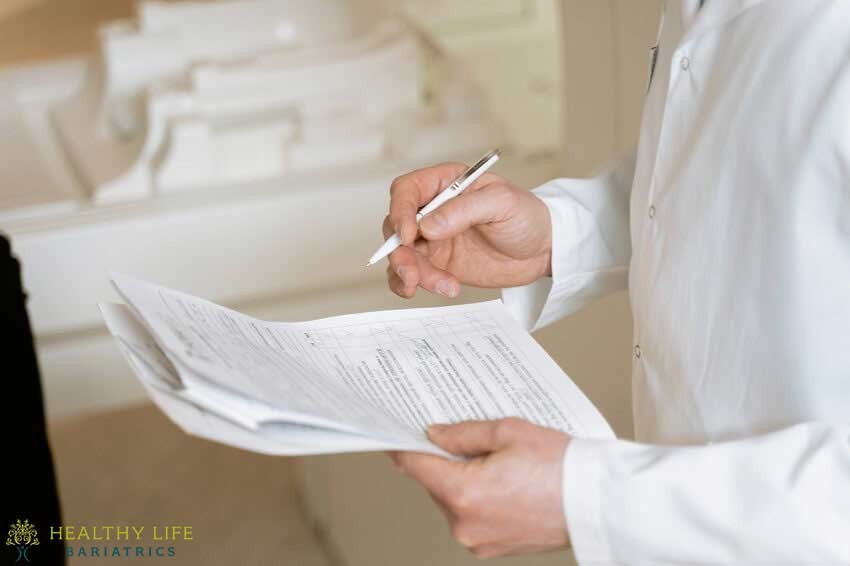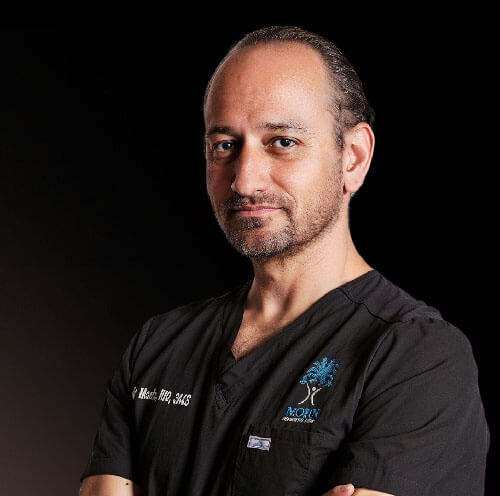
Paraesophageal Hernias: Causes, Anatomy, and Key Insights
A paraesophageal hernia is a type of hiatal hernia. The condition is less common than other hernia types. You are said to have a paraesophageal hernia when a portion of the stomach moves to settle next to the esophagus. The stomach does this by passing upward through an opening in the diaphragm called the hiatus. The diaphragm is the muscle separating the abdomen and the chest.
What Causes a Paraesophageal Hernia?
Experts are still determining why these rare hernias form. You should be aware of risk factors, such as weakening the diaphragm muscles that allow the stomach to reside beside the esophagus.
This weakening of the ab muscles can be caused at birth or by aging, traumatic injury to the abdomen, increased abdominal pressure from obesity, pregnancy, and heavy lifting.
What are the Symptoms of a Paraesophageal Hiatal Hernia?
Many people with paraesophageal hernias do not experience any symptoms. Asymptomatic hernias can go unnoticed for years and do not require surgery. If the hernia does lead to symptoms, surgery is needed. Paraesophageal hernia repair surgery will prevent severe symptoms from occurring. One such symptom is when the stomach tissue becomes strangulated, preventing it from reaching its blood supply. Strangulated organs require emergency surgery and can be fatal.
Other symptoms of paraesophageal hernia include heartburn, upper abdominal pain, difficulty swallowing, shortness of breath, vomiting of blood, black stool, and regurgitation of foods and liquids into the mouth.
Symptoms may include:
- Heartburn/Reflux – Stomach acid backs up (refluxes) more readily into the lower esophagus
- Chest Pain – Esophageal irritation or reduced blood flow causes painful sensations
- Nausea/Vomiting – The twisted stomach cannot empty well
- Trouble Swallowing – The esophagus narrows or gets obstructed
- Shortness of Breath – The stomach mass compresses part of a lung
What Causes a Paraesophageal Hernia?
Risk factors for paraesophageal hernias include:
- Congenital Defect – Existing since birth if connective tissues fail to seal correctly during development
- Prior Surgery - Scars near the esophageal hiatus may weaken the integrity
- Trauma – Any injury sharply increasing intra-abdominal pressure could cause sudden hiatal defects
- Obesity – Increased weight places extra pressure on the diaphragm, enabling herniation over time
Most paraesophageal hernias occur spontaneously later in life though, as aging tissues gradually stretch out while eating or straining. Those with connective tissue disorders like Marfan syndrome or Ehlers-Danlos syndrome have higher risks as well [2]. Fortunately, only 5% of all hiatal hernias reaching sizes enabling stomach herniation prove symptomatic enough to require intervention [3].
When Should You See a Doctor About Paraesophageal Hernia in Los Angeles?
If you are experiencing severe chest or abdominal pain, persistent nausea, vomiting, or difficulty with bowel movements or passing gas, these may be warning signs of a strangulated paraesophageal hernia. This serious condition requires immediate medical attention, as it can lead to life-threatening complications if left untreated.
Dr. Moein specializes in diagnosing and treating paraesophageal hernias in Los Angeles, CA, using advanced techniques to restore health and alleviate symptoms. A prompt evaluation by a qualified expert is essential to ensure effective treatment and prevent complications. Take your time. Call Healthy Life Bariatrics at (310)861-4093 today.
How is a Paraesophageal Hernia Diagnosed?

Dr. Moeinolmolki uses specialized X-ray imaging to view the esophagus directly. An endoscopy may also be used to view the hernia.
- Upper Endoscopy—A camera-scope examination of the esophagus, stomach, and duodenum that can visualize large herniated portions directly.
- Contrast XR Swallow Study: Patients drink chalky barium liquid, which enables X-ray delineation of abnormal esophageal anatomy and real-time motility as they stand and lie down.
- CT Scan – Further examines size and positioning of the stomach herniation if earlier tests remain indeterminate.
How is Laparoscopic Paraesophageal Hernia Performed?
This safe, minimally invasive surgery begins with general anesthesia. Once you are prepped and anesthetized for surgery, a few tiny incisions are made along the abdomen. These incisions function as openings for the laparoscopic camera and other surgical instruments.
The laparoscope has a light and tiny camera attached that allows Dr. Moein to view the internal structure of your abdomen on a nearby monitor.
During surgery, the herniated portion of your stomach is repositioned into place. The hiatal opening in the diaphragm is then stitched closed to prevent the hernia from recurring.
In some cases, the stomach doesn't want to stay in place. At that time, Dr. Moein will recommend fundoplication, which involves wrapping the top portion of the stomach (fundus) around the bottom of the esophagus. This extra step will stabilize the stomach and prevent it from re-herniating.
Laparoscopic Repair Techniques: Tension-Free vs. Primary Closure
Two main laparoscopic paraesophageal hernia repair techniques predominate currently:
- Tension-free hiatal hernia repair involves covering reconstructed hiatal tunnel deficits with soft mesh reinforcement to facilitate tissue incorporation without pull [5]. Studies find mesh augmentation decreases hernia recurrence from 20% to under 5% long-term.
- Primary crural closure uses only carefully placed sutures approximating muscle borders without implanted meshes due to added risks like stricture or erosion. Success relies upon meticulous scar tissue removal and tension-free repairs, which advanced minimally invasive techniques facilitate well vs. open surgery.
Advancements in Laparoscopic Paraesophageal Hernia Repair
Three-Dimensional Imaging Systems:
Recent advancements in laparoscopic technology include the integration of three-dimensional imaging systems. This enhancement provides surgeons with improved depth perception and spatial awareness during the intricate maneuvers involved in paraesophageal hernia repair(2).
Use of Biocompatible Mesh:
Surgeons may use biocompatible mesh to reinforce the repair and reduce the risk of recurrence. This mesh provides additional support and stability to the repaired area, promoting long-term success(3).
What are the Benefits of Laparoscopic Paraesophageal Hernia Surgery Los Angeles, CA?
There are several benefits to the surgical intervention of this less common hiatal hernia. There are smaller incisions and shorter recovery when compared to open surgeries. You also get less pain, less scarring, and less risk of infection.
What is Recovery Like for Laparoscopic Paraesophageal Hernia Surgery Los Angeles?
You will typically return home the same day after having surgery. You can plan on spending four to six weeks in recovery. Dr. Moein will advise you to avoid heavy lifting and strenuous exercise during that time.
Early: Week 1
- A hospital stay of 1-2 days with advancing mild nutrition
- Using PCA pumps and oral narcotic medications for surgical site soreness
- Preventatively inhaling with a spirometer and walking frequently
- Seeing temporary left shoulder gas referral discomfort improve
Middle: Week 2-4
- Consuming fabulous pureed foods, slowly progressing textures
- Weaning down to oral Tylenol or ibuprofen for residual pains
- Increasing activity gradually without any lifting limits
- Possibly driving short distances if off pain pills
Late: Week 5-8
- Advancing nutrition towards diverse standard textures
- Building back fuller diet capacity and exercise stamina
- Typically cleared for minimal restrictions around 8 weeks
Following individualized post-op instructions optimizes proper long-term healing. A month after surgery, most patients rapidly recover to full-strength eating without reflux or choking fear.
When to Consider Paraesophageal Hernia Repair Surgery
Dietary Guidelines for Paraesophageal Hernia Recovery:
Post-surgery, adhering to specific dietary guidelines is essential. Patients are often advised to follow a phased approach, gradually introducing solid foods while avoiding items that may cause irritation or reflux.
Managing Pain and Discomfort After Laparoscopic Repair:
Effective pain management is crucial for a smooth recovery process. Surgeons may prescribe medications and recommend non-pharmacological strategies to minimize discomfort during healing.
Activity and Lifestyle Modifications:
During the initial stages of recovery, patients are typically advised to avoid strenuous activities and heavy lifting. Lifestyle modifications, such as maintaining a healthy weight and avoiding smoking, contribute to long-term success.
Would you be ready to Discuss Paraesophageal Hernia Surgery in Los Angeles?
At Healthy Life Bariatrics, Dr. Moeinolmolki and his compassionate staff are ready to provide you with quality surgical care and shorter recovery times. If you have a paraesophageal hernia, or you suspect you do, schedule a consultation with Dr. Moein by calling from anywhere in Los Angeles, Encino, or Glendale, California – (310)861-4093.
Related to:

